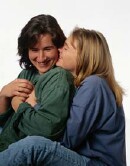
WEDNESDAY, May 16 (HealthDay News) — Some people actually may have “gaydar,” a widely used slang term for the ability to assess quickly another person’s sexual orientation, a new study suggests.
Researchers asked 129 college students to look at 96 photos of young men and women and to identify them as either gay or straight. The participants were 65 percent accurate in identifying gay and straight women and 57 percent accurate in identifying gay and straight men.
Faces in photos were free of glasses or jewelry, as well as scars, facial hair and non-earlobe piercings.
When the faces were viewed upside down, the participants’ accuracy slipped to 61 percent in identifying gay/straight women and 53 percent in identifying gay/straight men.
Still, that accuracy rate is higher than would be expected by chance alone, the researchers said.
The findings suggest that many people subconsciously make gay and straight distinctions, according to study author Joshua Tabak, a psychology graduate student at the University of Washington in Seattle.
“It may be similar to how we don’t have to think about whether someone is a man or a woman, or black or white. This information confronts us in everyday life,” he said in a university news release.
Tabak said the findings challenge the theory that if people kept their sexual orientation to themselves then discrimination against gays, lesbians and bisexuals would not exist. This type of argument is made by people who oppose anti-discrimination policies for these groups, the release noted.
It’s not clear why some people have better “gaydar” than others. Tabak suggested that “people from older generations or different cultures who may not have grown up knowing they were interacting with gay people” may be less accurate in identifying gay or straight people.
The study was published online May 16 in the journal PLoS One.
More information
The American Psychiatric Association has more about sexual orientation.

